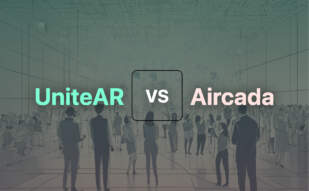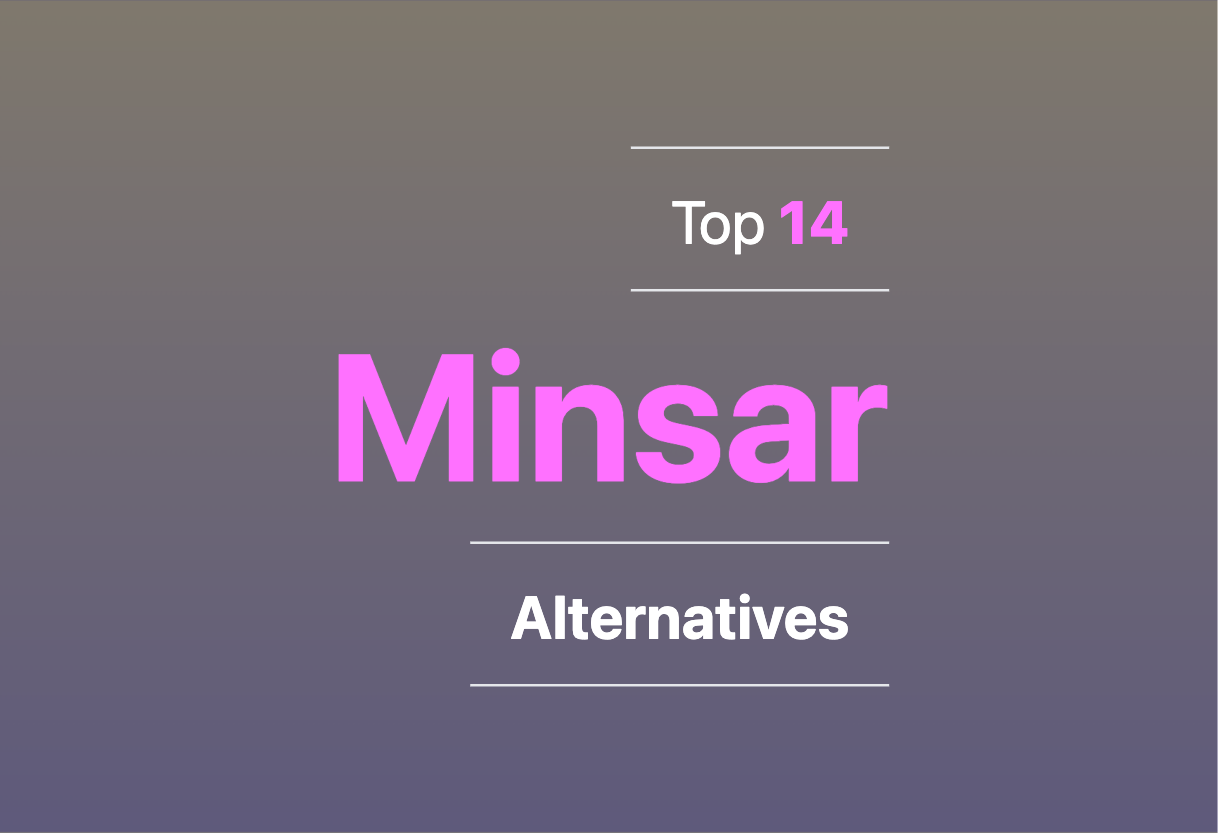
Aircada

Enter Aircada, the rebel of AR content creation platforms, a brainchild of the Chenoweth brothers, designed to knock your AR socks off. Launched in 2020, this platform employs cutting-edge Spatial AI, is device-agnostic, and can create AR experiences in a snap, positioning itself as a potent force in the AR software market.
Top Features that Make Aircada Shine
- No-Code AR Creation: You don’t need any coding prowess to create and deploy AR content. Aircada is pure magic, bringing your AR vision to life, sans the coding.
- Highly Intuitive: Even neo-AR enthusiasts can play around with automatic graphic creation and manage geometry occlusion. AR creation has never been so easy!
- Device Adept: Aircada is your AR companion across mobiles, tablets, or LIDAR-enabled gadgets. Its AR web applications evidently defy dogmas.
- Secure and Collaborative: With an integrated AR content management system and encrypted communication, Aircada secures, streamlines your operations, and promotes team collaboration.
- Global Reach: Aircada speaks in multiple languages, literally! Catering to a global user base with comprehensive documentation at aircada.com/docs.
| Canva of AR: | Creating AR content on Aircada is as easy as designing infographics on Canva. It’s an AR design party waiting to happen. |
| Spatio-Tech Brilliance: | With Spatial AI, real-world 3D model scanning & uploading capabilities, and swift AI-driven algorithms, Aircada is leaving footprints in the sands of AR tech time. |
| Seamless Integration: | Aircada effortlessly interfaces with other software & platforms, making it the darling of your AR stack. |
The Downsides of using Aircada
As of the present data, we can’t pick out any glaring letdowns tagged along with Aircada. However, no tool is perfect, and user feedback forms a critical part of enriching the tool, opining room for improvements.
Aircada Pricing
Now, there’s more, folks! Aircada’s unbeatable free edition lets you taste the AR rainbow. Kick start your journey with unlimited projects, 3D model scanning, and more. To dig deeper, grab the affordable plans starting from approximately $20/mo right up to enterprise plans for around $79/mo.
Aircada Use Cases
AR Enthusiasts & 3D Designers
With no-code AR content creation, intuitive functionality, and 3D scanning capabilities, Aircada empowers designers to whip up immersive AR experiences in no-time.
Marketers
Aircada is a marketer’s dream, offering customizable scenes, animations, custom interfaces, and QR codes to launch interactive marketing campaigns
OEMs & Industrial Equipment
Aircada caters to the industry-specific needs providing guided AR procedures and training to enhance equipment understanding and operation.
ARCore
Brought to life by Google,ARCore is a groundbreaking platform for constructing engaging and innovative augmented reality experiences. It stakes its prowess on APIs, pushing the boundaries of how your smartphone comprehends and engages with its environment. Offering support across Android and iOS, ARCore is a giant leap forward in the intermingling of the virtual and real worlds.
ARCore Prime Features
- Motion tracking for real-time analysis of device position and movement.
- Environmental understanding to facilitate interaction with the real world.
- Light estimation for realism in the AR experience.
- Crafting shared AR experiences across Android and iOS platforms.
- Upgraded with Geospatial API leveraging Google Maps.
- Open-source demo ‘Mega Golf’ for developers for hands-on experience.
| Feature | Benefit |
|---|---|
| Streetscape Geometry API | Access a 3D mesh within 100m radius of user’s location. |
| Geospatial Depth API | Improve depth measurements using building and terrain data up to 65m. |
| Scene Semantics API | Precisely label every pixel in an outdoor scene using AI. |
ARCore Limitations
- Potential compatibility concerns with Google Maps live view.
- Unauthorized installation issues reported with Google Apps.
ARCore Pricing
ARCore is Google’s robust offering to the AR community, made accessible free of cost. Enjoy the open-source features and scale your content experiences with liberty.
ARCore Use Cases
Use case 1 – Interactive Gaming
With ARCore’s precise motion tracking and environmental understanding, game developers can create deeply immersive experiences, revolutionizing the mobile gaming industry.
Use case 2 – Real Estate Visualization
ARCore’s depth and scene semantics APIs empower realtors and architects to create vibrant, fully dimensional property walkthroughs that allow clients to visualize spaces interactively.
Use case 3 – Education
ARCore enhances learning by creating interactive, context-rich educational content, allowing learners to explore scientific concepts, historical events, and complex theories in an engaging, three-dimensional environment.
Three.js
Brought to life by Ricardo Cabello and a group of dedicated developers, Three.js has been transforming the graphic scene since its first release in April 2010. Serving as a cross-browser JavaScript library and API, it effortlessly creates and presents animated 3D computer graphics in any web browser without any need for plugins.
Three.js Top Features
- GPU-accelerated 3D animations simplified by JavaScript
- Application of high-level libraries such as Three.js, GLGE, and Scene.js ensuring easier creation of complex 3D animations
- Supports Virtual and Augmented Reality via WebXR
- Runs in all browsers endorsing WebGL 1.0.
| Feature | Benefit |
|---|---|
| Multiple effects, cameras, and animations | Offers depth and variety to your graphic creations |
| Multiple scenes, lights, and materials | Adds realism and character to the 3D animations |
| Over 1700 contributors on Github | Continually updated and improved by the ever-growing community |
Three.js Limitations
- Limited to browsers that support WebGL 1.0
Three.js Pricing
Under the MIT License, Three.js is available for free, promoting open-source programming.
Three.js Use Cases
Importance for 3D Modeling
Three.js comes in handy for 3D modeling, allowing users to code and view their models right after it loads. The rotation of the cube along its x and y axes signifies the versatility of this tool.
Animation Creation
Those pursuing Animation Creation can rely on Three.js for creating intricate 3D animations with a few simple steps due to the variety of materials, lights, and scenes it provides.
Virtual and Augmented Reality
But perhaps the most noteworthy usage is in the realm of Virtual and Augmented Reality, where Three.js shines with its WebXR support, opening avenues for much more immersive experiences.
Heaps

Step into the world of Heaps, a mature cross-platform graphics engine powered by the Haxe programming language and preferred by industry leaders for high-performance game development. With both 2D and 3D capabilities, Heaps has etched its mark in the gaming industry with top-tier offerings such as Rushberry Mercs, Voidrun, Nuclear Blaze and Evoland.
Heaps Top Features
- Holds the prowess of leveraging modern GPUs, ensuring consistent high-quality graphics.
- Powerful flexibility across multiple game genres such as Arcade, Role-Playing, Real Time Strategy, and Turn Based strategy games.
- Known Performance optimization and stability, as displayed in acclaimed games like Dead Cells and Northgard.
- Strong community roots within indie game development offering a beneficial network for creators and developers to share content.
| Unique Feature | Rationale |
|---|---|
| Developed in Haxe | The Haxe programming language offers high portability, allowing easy integration into any codebase. |
| Pioneer of Haxe | Pioneered by Nicolas Cannasse, one of Haxe’s creators, and founder of Shiro Gaming – the company behind popular games like Dead Cells and Northgard. |
| Potential Replacement for Flash | With Flash’s demise, Heaps represents an excellent alternative with platform-independent benefits. |
Heaps Disadvantages
- Contrary to Godot and Unity, Heaps is more of a library than a full-featured game engine.
- The transition from Flash to Haxe may necessitate a learning curve for some users.
Heaps Pricing
As an open-source engine, Heaps offers its underpinning technology free of charge, allowing developers to leverage the tool without constraint and fostering creative freedom.
Heaps Use Cases
Use case 1 – Indie Game Development
Heaps is ideal for indie game developers seeking performance optimization and stability. It offers a robust platform for creating high-performance games with deep storylines and complex game systems.
Use case 2 – Game Content Sharing
With a strong community association, Heaps is beneficial for developers and creators looking to share content and collaborate with a network of passionate peers.
Use case 3 – Flashed-Based Game Development Transition
For developers moving away from Flash, Heaps, underpinned by Haxe, offers an excellent platform-independent alternative, offering tangible opportunities for the future.
Stride
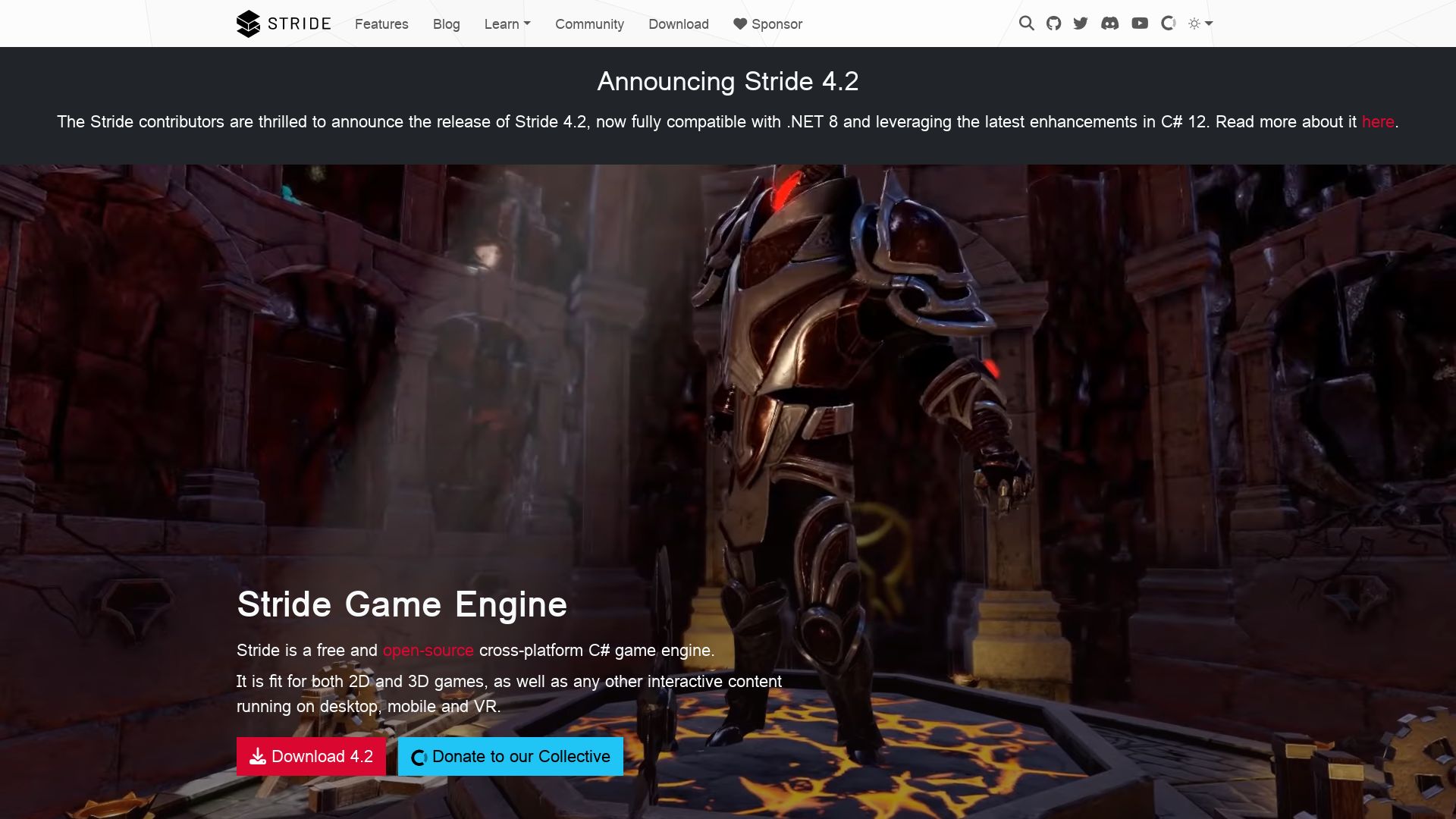
Engineered by Silicon Studio, Stride is a free and open-source 2D and 3D cross-platform game engine. Originally known as Xenko, it is designed for creating video games for PC, mobile devices, and virtual reality.
Stride Top Features
- Comprehensive C# suite tools
- Customizable shader system
- Game Studio, an integrated environment for asset import, scene creation, and arrangement using Entity component system, script assignment, game build and run
- Robust in-built assets including Physically-Based Rendering (PBR) layered material editor, photorealistic postprocess effects, particle editor, sprite editor, scene streaming system, scripting editor, and UI engine
| Platform Support | iOS, Android, Windows UWP, Linux, PlayStation 4 |
| Additional Applications | Used as a 3D rendering engine for the visual programming environment vvvv gamma |
| Licensing | Dual-licensed under MIT License |
Stride Limitations
- Heavy reliance on community support after Silicon Studio’s end of support
- Some legacy features may have been discontinued or are in need of modernization
Stride Pricing
Stride is completely free, sustaining its development through its open-source community guided model.
Stride Use Cases
Use case 1
Stride is perfect for indie game developers, offering a rich and robust toolset for creating complex, visually stunning video games for multiple platforms, all under no cost.
Use case 2
Education sectors can adopt Stride as a learning tool. Students aspiring to enter the game development sector can experiment and learn directly from Stride’s open-source code.
Use case 3
Digital artists can use Stride for its impressive rendering capabilities and photorealistic postprocess effects for creating virtual reality and other visual interactive experiences.
SpriteKit
![]()
Enter the vibrant world of SpriteKit, a power-packed game development framework designed for the iOS and macOS ecosystems. Its user-friendly and cross-platform capabilities coupled with engaging 2D game creation are a draw for developers worldwide.
SpriteKit Top Features
- Supports creation of compelling 2D games, with tools for animation and physics-based gameplay.
- Provides a seamless interface for constructing and animating 2D game objects, thanks to its architecture over the SceneKit framework.
- Embraces the power of Apple’s own Swift language for game development, enhancing code efficiency.
- Employs the Box2D physics engine for realistic object interactions and provides features like scene editing, animation, physics and particle systems.
- Adept at cross-platform game creation through Game Center and iCloud support.
| Components | Description |
|---|---|
| Scene | Root object that delivers the visual rendering of all content. |
| Node | Acts as the building blocks of every SpriteKit game. |
| Sprite | Handling entity for graphic rendering of game characters and objects. |
| Action | Enables sequenced animation and changes to nodes. |
SpriteKit Limitations
- Limited to the iOS and macOS ecosystem, restricting development to only Apple devices.
- Requires proficiency in Swift and iOS application development which may pose a challenge for beginners.
- While it offers great performance, certain elements – like the alpha mask – may compromise it for the sake of precision in object collisions.
- Restriction in form of a compromise between performance and collision accuracy.
SpriteKit Pricing
As a part of the macOS, iOS, and tvOS developer tools, SpriteKit is freely available for those developing within the Apple ecosystem.
SpriteKit Use Cases
Use case 1
For developers seeking a fast and efficient 2D game development platform within the Apple ecosystem, SpriteKit offers a user-friendly and Swift-based solution. Its consistent updates and support from Apple guarantee future-proof development.
Use case 2
For MVP methodologies and game analytics, SpriteKit’s enhanced speed and efficiency save both time and resources. Its features allow for fast prototyping and iteration, making it ideal for startups and independent game developers.
Use case 3
For applications needing physically realistic interactions and animations, the in-built Box2D physics engine of SpriteKit and its sequencing of node actions offer great benefits.
ARKit
Meet ARKit, Apple’s groundbreaking Augmented Reality (AR) platform. Launched in 2017 as a key feature of iOS 11, ARKit uses the Visual Inertial Odometry technology for tracking movements. With each iOS update, ARKit evolves, promising a transformative AR experience.
ARKit’s Top Features
- 4K video capture allows users to create high-quality AR experiences, instrumental for video editing, film production, and enhancing social media content.
- Supports High Dynamic Range (HDR) video and high-resolution imagery capture, facilitating precise and realistic AR.
- A noteworthy extension of location anchors includes cities like Montreal, Sydney, Singapore, Tokyo, adding geographic diversity.
- Improvements in Motion Capture enable accurate rendering of human performances into AR.
- Simultaneous use of front and back cameras, portraying AR content interaction using facial expressions.
- Scene Geometry for space mapping that tags floors, walls, and other physical objects.
- People Occlusion enables AR content to navigate seamlessly behind and in front of people in the real world.
- Motion Capture can detect up to 100 images at a time, enhancing physical object recognition in 3D.
| Feature | Benefit |
|---|---|
| High-resolution image capture during the AR session | Aids in image quality and viewer immersion |
| Direct control of camera settings through EXIF tags | Enhances the user’s overall control and creative freedom |
| Object Capture and Character Control capabilities in ARKit 5 | Potentially transforms AR gaming and storytelling experiences |
ARKit Downsides
- Dependency on the environment’s lighting conditions and flat surfaces for accurate visual odometry.
- Requires significant input from device sensors like cameras, accelerometers, and gyroscopes.
- To fully leverage all features, the user must have latest iPhone X and iPad Pro models.
ARKit Use Cases
Use case 1 – Gaming
ARKit excels in game development. The advanced rendering with RealityKit 2 and motion capture capabilities offer a fully immersive, interactive gaming experience.
Use case 2 – Film Production
The 4K video capture and high-resolution image capture provide remarkable assistance in film production, enhancing visual storytelling.
Use case 3 – Indoor Navigation
ARKit shows promise for indoor navigation systems. By integrating GPS and Bluetooth beacons, it could guide users within large establishments like shopping malls, airports, and convention centers.
Unity

Lorem ipsum dolor sit amet, consectetur adipisicing elit, sed do eiusmod tempor incididunt ut labore et dolore magna aliqua. Ut enim ad minim veniam, quis nostrud exercitation ullamco laboris nisi ut aliquip ex ea commodo consequat. Duis aute irure dolor in reprehenderit in voluptate velit esse cillum dolore eu fugiat nulla pariatur. Excepteur sint occaecat cupidatat non proident, sunt in culpa qui officia deserunt mollit anim id est laborum.
Unity Best Features
- Powerful game development engine: Unity provides the capability for creating 3D and 2D games efficiently.
- Compatibility: With Unity, developers can launch cross-platform games including popular platforms such as Android and iOS. It is compatible with a myriad of operating systems, not limited to just game development, but extends to creating AR applications and 3D simulations.
- Advanced tools and features: Unity offers a suite of tools, rendering technology, and features to facilitate high-quality game creation.
- Active developer community: Unity has a supportive developer community offering assistance, problem-solving ideas, and feedback for system improvement.
- Asset Store: Unity boasts a richly populated asset store full of pre-designed textures and features, aiding developers in crafting intricate game designs.
| Programming Language Support | BOO script, JavaScript, C# |
| Pro Version Features | |
| Enhancements | Continuously adapts and improves for user-friendly, immersive visual experiences |
Unity Limitations
- Unpredicted pricing changes: Without a proper announcement, Unity’s sudden changes to the pricing structure caused an erosion of trust between the company and its users.
- Implications for indie developers: The new per-install fees might potentially compromise the financial sustainability of solo, indie, and mobile developers, who fear repeated downloads by a single user.
- Hampering digital preservation: The new charges stirred concerns around harming digital preservation efforts.
Unity Pricing
From January 1, 2024, Unity will implement a new pricing model. Developers will need to pay a fee each time a game using Unity software is installed. However, developers will not be levied this fee until their game reaches $200,000 in revenue and exceeds 200,000 installations. Games purchased in standard markets like the US and UK bear a higher fee than in emerging markets like India and China. A free and Pro version of Unity are available, boasting many features beneficial for sophisticated game production.
Unity Use Cases
Use case 1: Cross-platform Game Development
Unity’s compatibility with a multitude of operating systems and its powerful engine make it an ideal choice for developers seeking to create cross-platform games.
Use case 2: Augmented Reality Applications
Unity supports developers in crafting interactive AR (Augmented Reality) applications, thanks to its immense adaptability across operating systems.
Use case 3: 3D Simulations
With Unity, creating 3D simulations becomes a seamless process, proving highly beneficial for game developers requiring advanced 3D game designs.
AR Foundation

Created by Unity, AR Foundation is an enabling framework for AR experiences on Android and iOS. It forms the crux of AR projects, fostering motion tracking, environmental understanding, and lighting estimation.
AR Foundation Top Features
- End-to-end support for ARCore and ARKit devices
- Camera
Sceneform
A 3D frame created by Google, Sceneform is an AR creation tool designed specifically for Java developers, focusing on mobile use. Characterised by ease-of-use and its capacity to develop dynamic 3D models, Sceneform makes for a versatile tool.
Sceneform Top Features
- One-touch feature enabling 3D scenes rendering
- Dynamic 3D model creation
- Supports optional AR apps
- Easy navigation with AR overlay implementation
- Beneficial Augmented Faces function for detecting faces and creating overlays
| Feature | Description |
|---|---|
| Procedural Geometry | Enhances 3D drawing experience via experimenting with position, color, and lights. |
| ARCore Functionality | Empowers video playback management by identifying when an image is camera-tracked |
| Unique AR Features | Enables object scaling, 3D model motion, and rotation, along with AR experience recording |
Sceneform Limitations
- Compatibility issues with certain devices
- Limitations in 3D model creation
- Vertical surface detection and multi-camera operation unsupported
- No active maintenance or anticipated future updates from Google
Sceneform Pricing
As of now, Sceneform operates on an open-source model, indicating no direct costs associated with its usage.
Sceneform Use Cases
Use case 1
App developers looking to create applications with optional AR features find Sceneform handy, thanks to it supporting both AR-Required and AR-Optional Apps.
Use case 2
For projects requiring dynamic shaping like squares, cubes, or cylinders during runtime, Sceneform provides a lightweight and efficient solution.
Use case 3
Sceneform’s utility shines in apps requiring face detection and overlay implementation, empowered by its unique Augmented Faces function.
Vuforia

An Augmented Reality software development kit, Vuforia delivers advanced computer vision technology. Founded by Qualcomm and acquired by PTC Inc. in 2015, Vuforia enables AR application creation with features like object recognition, real-time detection, and multiple target types.
Vuforia Top Features
- 2D/3D target types including markerless Image Targets, 3D Model Targets, and addressable Fiducial Markers (VuMarks).
- Advanced 6 DOF device localization and localized occlusion detection.
- Capability for real-time detection and overlays with data on real-world objects through the Vuforia Engine.
- The VuMark feature, a next-gen QR code with custom design and multiple formats.
- Comprehensive compatibility with multiple platforms including iOS, Android, UWP, and AR headsets/glasses like HoloLens 1 and 2, Magic Leap, and RealWear HMT-1 among others.
| Feature | Description |
|---|---|
| Cloud Recognition Database | Enables remote target image storage |
| APIs | Available in C++, Java, Objective-C++, .NET languages for Unity game engine |
| AR Digital Twin Focus | Bridges physical and digital spaces |
Vuforia Limitations
- Cloud add-ons are not available in China.
- Virtual buttons feature is deprecated in Vuforia, and set to be removed in future versions.
- The premium plan is non-cancellable without direct contact with the company.
Vuforia Pricing
Vuforia offers different licensing options including a free Develop license for learning and non-commercial use. Its Basic plan allows unlimited app development and publishing without watermark. The Premium plan enables unlimited development and app publishing with extended features. There are also Cloud and Cloud Plus add-ons available, to increase Cloud Recognition limits. Cloud add-on overage is charged at a standard rate of $0.01/Cloud reco.
Vuforia Use Cases
Use case 1: AR Application Development
Vuforia is integral for creating AR applications, thanks to its high-grade computer vision technology and object recognition abilities. Developers use its extensive compatibility, potent APIs, and real-time detection feature to bring app ideas to life.
Use case 2: Interactive Campaigns
This AR toolkit supports the creation of interactive campaigns. By combining 2D/3D target types and the advanced VuMark feature, marketers can create engaging and visually stunning campaigns.
Use case 3: 3D product demonstrations
Vuforia capitalizes on its AR prowess to aid in creating 3D product demonstrations. Its model target features and real-time overlay capabilities help represent products in dynamic and immersive formats.
Unreal Engine
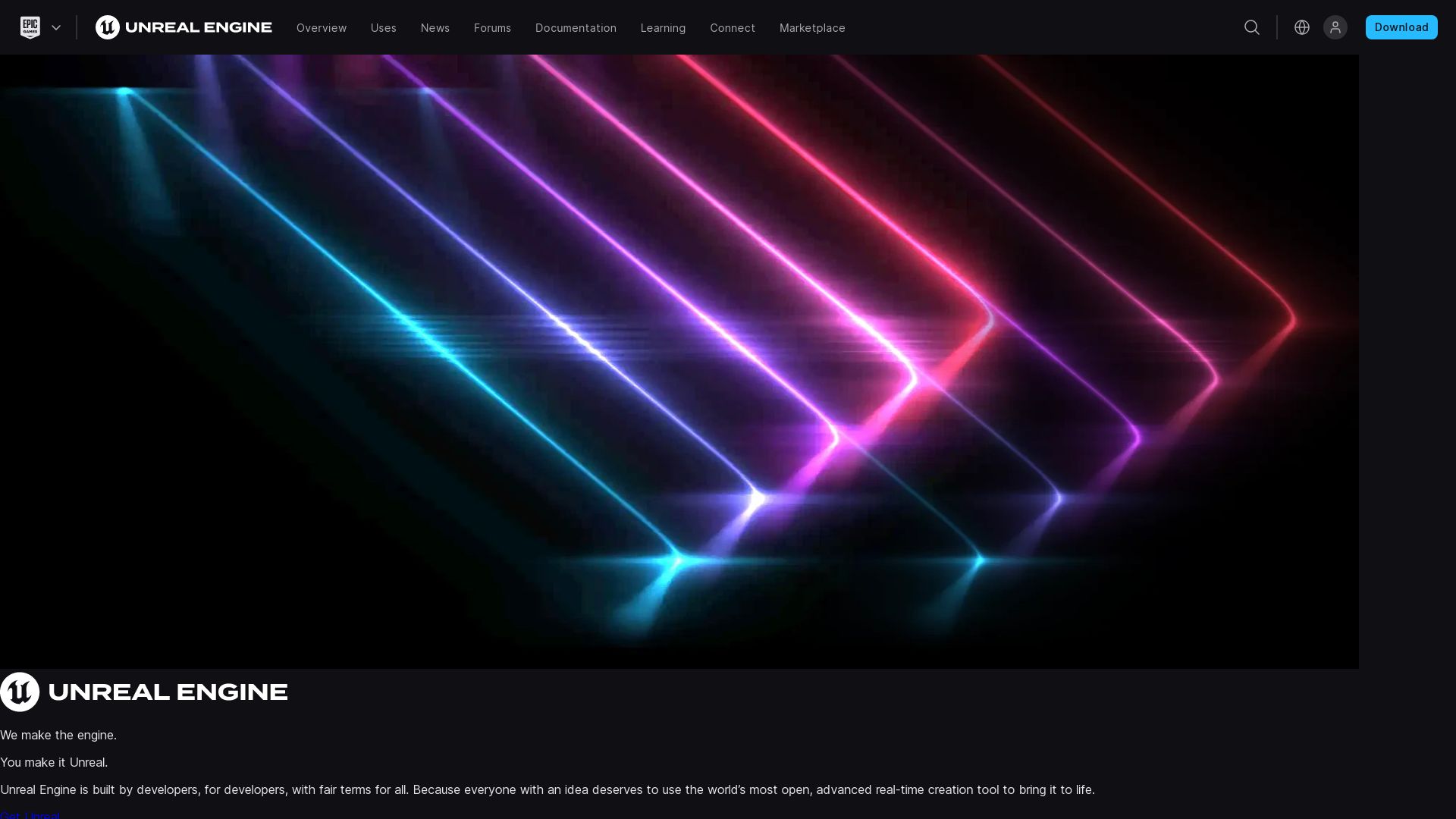
Emerging in the realm of AR creation tools is the innovative, versatile, and renowned Unreal Engine. This comprehensive tool, engineered by Epic Games, has evolved from catering to PC-based first-person shooters to encompassing varied game genres across assorted industries, including film and television.
Unreal Engine Top Features
- Wide platform support: Written in C++, Unreal Engine accommodates diverse platforms, from desktop to mobile, console, and VR.
- Innovative editor: The package includes UnrealEd, a sophisticated level editor underpinning real-time constructive solid geometry operations.
- Broad modding options: Unreal Engine 3 provided a liberating workspace for modders and developers.
| Feature | Advantage |
|---|---|
| Unreal Development Kit (UDK) | Introduced in 2009, the free version of UE3’s SDK supports the development of iOS games and apps. |
| Unreal Engine Marketplace | This platform enables creators to capitalize on their creations or purchase the work of other developers. |
| Free for educational institutions | Schools and universities have open access to the benefits of Unreal Engine at no cost. |
Unreal Engine Limitations
- The 5% revenue share may be burdensome for high-grossing commercial uses.
- Despite its wide reach, certain devices and platforms may not be supported.
Unreal Engine Pricing
Unreal Engine employs a fair pricing model that waives royalty charges for games published on the Epic Games Store. However, it requires 5% of revenues over USD 1 million for commercial use.
Unreal Engine Use Cases
Use Case 1: Game Development
Invariance in the gaming industry, Unreal Engine’s capacity for rich graphics and seamless performance equip it to facilitate highly immersive gaming experiences.
Use Case 2: Film and TV Industry
By appropriating AR tech imaginative storytelling, developers can leverage Unreal Engine for creating captivating cinematic narratives that resonate with audiences.
Use Case 3: Education Sector
As an accessible, free tool for universities and schools, Unreal Engine democratizes the creation of interactive learning environments, enhancing pedagogical efficacy.
jMonkeyEngine
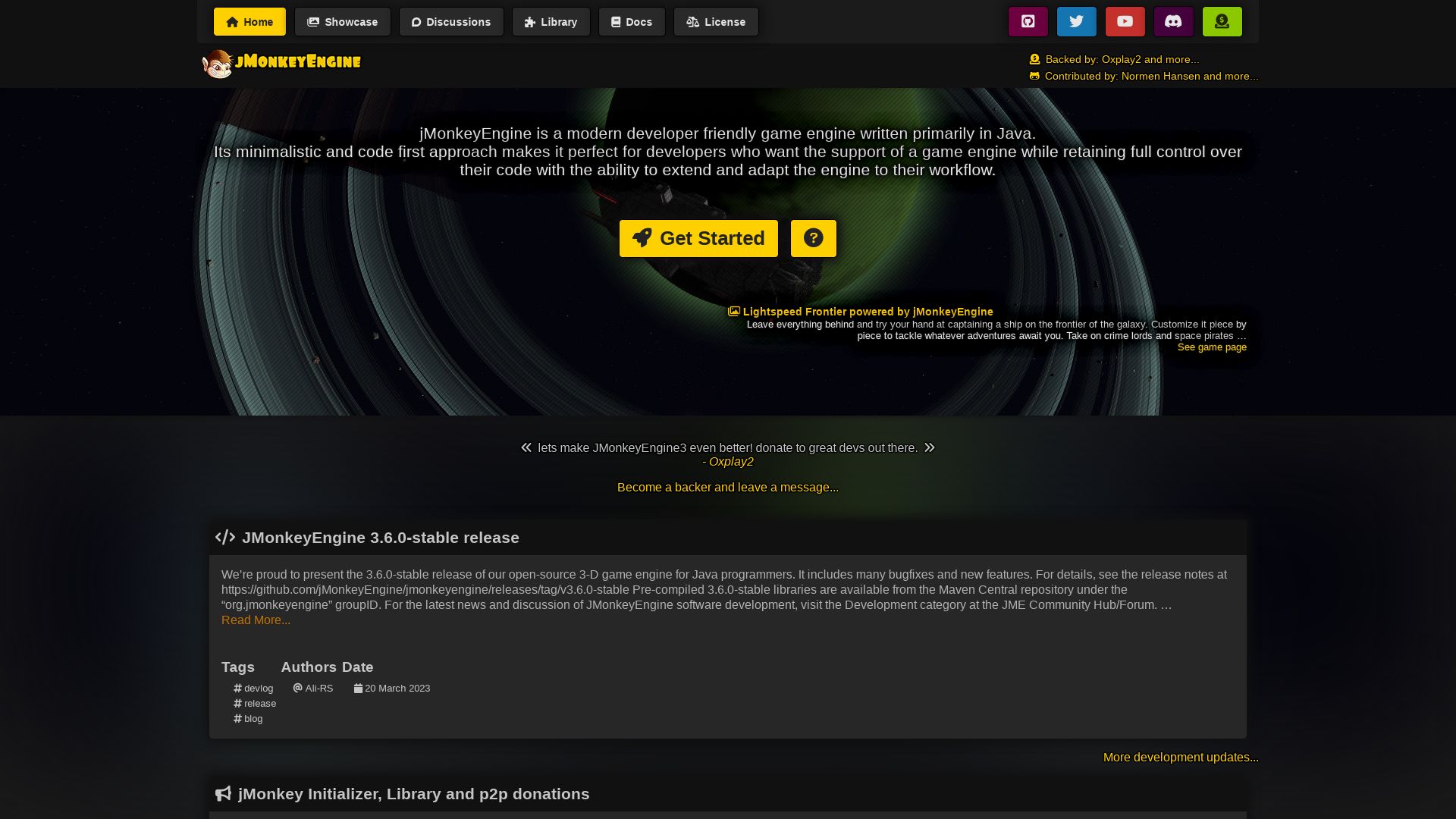
Welcome to jMonkeyEngine – an open-source, free 3D game engine developed in Java. For developers seeking a code-first approach to game development, jMonkeyEngine rises to the challenge with its latest update 3.6.0–stable release, equipped with a plethora of optimizations and fixes.
jMonkeyEngine Top Features
- NetBeans Platform Support and compatibility with Android, promising rapid, efficient game development.
- A variety of GUI options, including Lemur, Nifty GUI, and IGUI, provide user-friendly interaction interfaces.
- Integration with multiple physics solutions such as jBullet and Minie ensures realistic games.
- Benefit from post-processing support and filters like Bloom FXAA, Light Scattering, and more for stellar visual effects.
- The engine boasts advanced particle capabilities, enhancing the dynamism and realism of the created game worlds.
| 3D audio support with OpenAL | For immersive auditory experiences. |
| jMonkeyEngine Initializer | A handy web tool for project initiation. |
| Various Networking Options | Options like Spidermonkey, SimEthereal, and Monkey Netty enhance multiplayer experiences. |
jMonkeyEngine Limitations
- Its minimalistic design might not be appealing to all, considering a high degree of coding knowledge is required.
- Lower-level game development tool, which while extremely competent, might not cater to extreme high-end 3D game development needs.
jMonkeyEngine Pricing
Here’s some good news – jMonkeyEngine is available free of charge! Its open-source nature under the permissive BSD 3-Clause license makes it accessible to all.
jMonkeyEngine Use Cases
Use case 1: Game Development Education
jMonkeyEngine’s simplified approach makes it a favored choice for game-education programs. By using resources like Greenfoot, Alice, and Kojo, it facilitates game development education for children.
Use case 2: Indie Game Development
With its comprehensive features, jMonkeyEngine serves as a robust tool for indie game developers. The engine makes it feasible to create high-quality games even with lower system requirements.
Use case 3: Cross-Platform Game Publication
Thanks to its cross-platform compatibility, jMonkeyEngine is beneficial for developers looking to swiftly publish their games across different operating systems like PC, Linux, iOS, Android, and Mac.
Babylon.js
Get ready to dive into the vibrant world of Babylon.js. It’s not just a 3D engine, it’s a universe of potential at your fingertips, boasting real-time 3D graphics on web browsers all with the magic of HTML5. The brainchild of David Catuhe, today it thrives with influencers from Microsoft and over 190 contributors and artists, like Michel Rousseau, shaping it.
Top Innovations of Babylon.js
- Physically based rendering: This isn’t your father’s pixel rendering- Babylon.js makes photo-realism a priority.
- Cannon.js and Oimo: When you need a dose of physics, Babylon.js plugs right into these engines, delivering tangible collisions and experiential physical reactions in your virtual worlds.
- Animation Prowess: Key-frame animation objects deliver character animations in nuanced detail, heightened by the power of skeletons with blended weights.
| TypeScript to JavaScript | Worries of complex code fall away, as TypeScript melts into JavaScript, providing the most seamless experience for developers. |
| GitHub and Apache License 2.0 | Babylon.js raises the bar for openness, handing out its source code under Apache License 2.0. |
| Interactive API | It doesn’t just offer capabilities- it knits them right into your projects with its user-friendly API. |
Babylon.js Limitations
- Limited Constructive Solid Geometry: The functions of union, subtraction and intersection of shell models might pose a constraint.
- Reliance on Plug-in Physics Engines: To simulate real-world contexts, Babylon.js leans on external engines.
- Requires HTML5 and WebGL Supporting Browsers: To interpret the 3D engine and user code, compatible browsers are a prerequisite.
Cost-Free Magic of Babylon.js
Brace yourself for a revolution in 3D engine tech that won’t dent your wallet. Babylon.js is completely free, bursting with features and possibilities as wide as the cosmos. Its open-source nature is a love letter to the world of innovators and creators out there.
Babylon.js Use Cases
Educational Innovations
Educators can take students on a journey through the human body, make them privy to the intricate workings of the heart or bone structure. Babylon.js makes medicine tangible.
Military Training
The run-of-the-mill training modules can take a side-step as virtual worlds infused with real-world physics make military training a high-end video game, except it teaches vital skills.
Product Design
Designers get to play architects of new worlds, experimenting and visualising their designs in a 3-dimensional space. Babylon.js elevates product design from a concept on paper to interactive modeling.
Patrick Daugherty
Content writer @ Aircada. Merging AR expertise with a love for late-night gaming sessions.




